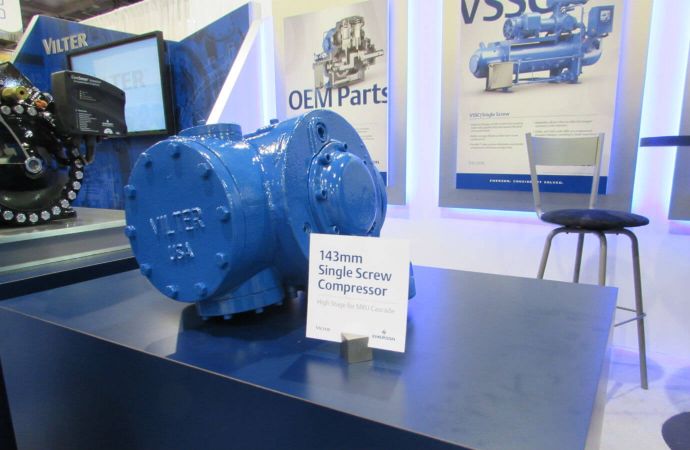The Modular Rooftop Unit employs CO2 or glycol as a secondary fluid.

VIlter screw compressor used in low-charge unit
Vilter Manufacturing, a subsidiary of Emerson, will release its of NH3/CO2/glycol packaged Modular Rooftop Unit (MRU) later this year, following a series of tests at Vilter’s headquarters in Cudahy, Wis.
The penthouse unit is the latest low-charge-ammonia packaged system to enter the marketplace as industrial end users seek safer, smaller and more flexible systems that reduce their regulatory responsibility.
The Vilter modular unit has been designed to offer end users a choice between a glycol-based secondary system serving coolers and docks, or a CO2 secondary system for low-temperature applications. In both cases, ammonia does not enter the refrigerated space.
“The industry is changing, so we designed this product with [the market] in mind,” said Gary Chafee, district sales manager, Vilter, in a presentation at the IIAR Natural Refrigeration Conference & Expo, held in Phoenix March 4-6.
“Obviously we have a low-charge system so we have helped reduce the leak rate, compliance costs and regulatory burdens dramatically,” Chafee said.
The industry is changing, so we designed this product with [the market] in mind.”
– Gary Chafee, district sales manager, Vilter
Vilter introduced the MRU at the 2018 IIAR Natural Refrigeration Conference & Expo. Since then the company has put the unit through a series of tests on the ammonia and CO2 skids; the last tests are on the cascade heat exchanger and the defrost system. “We are happy with the modifications we made to the unit,” said Wayne Wehber, VP business development, Vilter, who also spoke at the 2019 IIAR event.
The company initially said the ammonia charge would be under 200 lbs, but is still working on getting down to the “lowest possible charge,” said Wehber.
The MRU ranges in capacity from 55-85 TR for freezing, 28-40 TR for blast freezing, 75 TR for coolers, and 95 TR for docks. The unit contains two ammonia circuits for redundancy, each with a 143-mm single-screw compressor designed to use with a variable frequency drive. It also features: an air-cooled condenser on the roof, evaporators in the penthouse rather than hanging evaporators that would take up storage space; two glycol pumps; and four to six CO2 semi-hermetic reciprocating compressors.
Each of the ammonia skids comes with its own cascade heat exchanger, where ammonia condenses CO2. An advantage of that configuration is that in the event that CO2 and ammonia accidentally mix to form system-clogging ammonium carbonate in one skid, the other takes over.
Vilter elected to use an air-cooled condenser because “water usage is more of an issue,” Chafee explained. “For an 80 ton load running 6,000 hours a year, you're going to use 1.3 million gallons of water with the a fluid cooler or evaporative condenser. That's a lot of water.”
Vilter sees the MRU being employed in the retrofit market and in expansions as well as new construction. It can be employed as a “plug-and-play package, or components can be used individually.
Related stories





